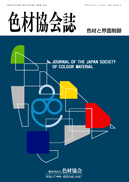All issues

Predecessor
Volume 87, Issue 1
Displaying 1-5 of 5 articles from this issue
- |<
- <
- 1
- >
- >|
Original Research Paper
-
Masaki MATSUI, Yasuhiro KUBOTA, Kazumasa FUNABIKI2014 Volume 87 Issue 1 Pages 3-12
Published: January 20, 2014
Released on J-STAGE: April 20, 2014
JOURNAL FREE ACCESSThe melting point of 1-alkyl-2-[4-(dialkylamino)styryl]pyridinium dyes was found to depended on the counter anions and the alkyl substituents. The counter anion had the greater influence, with the melting point ranging from 249 to 81.6°C in 1-butyl-2-[4-(diethylamino)styryl]pyridinium dyes. Then, the melting point was affected by the alkyl substituents. 2-[4-(Didecylamino)styryl]-1- dodecylpyridinium bis(perfluorobutylsulfonyl)imide exhibited the lowest melting point at 27.2°C.View full abstractDownload PDF (2541K)
Current Topics
-
Masanobu NAITO2014 Volume 87 Issue 1 Pages 13-18
Published: January 20, 2014
Released on J-STAGE: April 20, 2014
JOURNAL FREE ACCESSBlue mussels are typical marine fouling organisms which occasionally form clumps or aggregates on rocks, marine structures and ship's hulls. When the blue mussel attaches itself to these structures adhesive proteins known as “byssus” are secreted. The blue mussel can then achieve robust adhesive ability through insolubilization of the byssus. The byssus consists of L-dihydroxyphenylalanine (L-DOPA) generated by post-translational modification of tyrosine. The DOPA plays crucial role in its adhesive mechanism. Recently, the adhesion mechanism has been taken up as a prominent model for aqueous adhesives. The present paper gives a comprehensive overview of the adhesive mechanism of the blue mussel along with state-of-the-art examples of blue mussel-inspired aqueous paints or adhesives.View full abstractDownload PDF (2915K)
Review
-
Tomohisa NORISUYE, Kazuki SUGITA, Hideyuki NAKANISHI, Qui TRAN-CONG-MI ...2014 Volume 87 Issue 1 Pages 19-24
Published: January 20, 2014
Released on J-STAGE: April 20, 2014
JOURNAL FREE ACCESSWe have developed a dynamic sound scattering(DSS)technique utilizing high frequency ultrasound pulses in order to provide a novel analysis method for optically turbid microparticle suspensions. By using the technique, the particle size and the hydrodynamic interactions were evaluated for the micron-sized particles dispersed in a liquid without drying nor dilution of the sample. Since the technique allows us to visualize the structure of the particles in the suspension thanks to the phase information of the scattering pulse, it could be a promising technology to understand the microstructures in highly turbid suspensions by online monitoring of the sample in the manufacturing process.View full abstractDownload PDF (7128K)
Serial Lecture
-
Megumi SADAIE2014 Volume 87 Issue 1 Pages 25-30
Published: January 20, 2014
Released on J-STAGE: April 20, 2014
JOURNAL FREE ACCESSThe outer-facing surface of cuticle sheet which is typically 0.5 µm thick is covered with a monomolecular layer of 18-methyleicosanoic acid (18-MEA)which is bound via a thioester linkage to a protein. Frictional properties of human hair at both root and tip were investigated using a quantitative friction map(QFM)created from friction force microscopy(FFM)detecting the friction force at a molecular level. QFM showed several differences in frictional properties of hair root and tip. The present paper describes the micromorphology and chemical structure of hair surface by consideration of frictional properties.View full abstractDownload PDF (6695K)
-
Shintaro KOBAYASHI2014 Volume 87 Issue 1 Pages 31-35
Published: January 20, 2014
Released on J-STAGE: April 20, 2014
JOURNAL FREE ACCESSX-ray diffraction, which is by nature a non-destructive analysis method, has been widely used to obtain information about the interior of bulk and powder samples. Recently, a technique to control the depth of the detection area was developed. This is based on controlling the penetration depth of the X-ray from the sample surface by using a parallel beam and grazing-incident geometry, which uses a very small incident angle, allowing crystalline-quality evaluation and qualitative analysis on the sample area at the desired depth from the surface. Also developed was a derived technique, called reflectivity analysis, which provides information about the thickness, density and interface roughness of the layers in a layer-structured sample. This paper introduces the fundamentals of the measurement principles, instruments and applications of these X-ray surface measurement techniques.View full abstractDownload PDF (2419K)
- |<
- <
- 1
- >
- >|